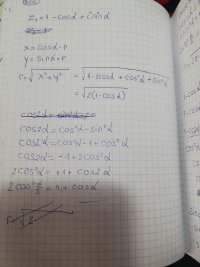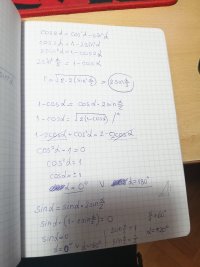You are using an out of date browser. It may not display this or other websites correctly.
You should upgrade or use an alternative browser.
You should upgrade or use an alternative browser.
Complex number into a trigonometric form
- Thread starter Loki123
- Start date
D
Deleted member 4993
Guest
Start with the identity:Turn z=1-cosa+isina into a trigonometric form.
I attached my work but I think it's pretty useless. I have no idea how they got the correct solution which is on the third picture. View attachment 31510View attachment 31511View attachment 31512
1 - cos(α) = 2 * sin2(α/2)
did you have a look at my work? I tried that and got nowhere, so I need a little more information please.Start with the identity:
1 - cos(α) = 2 * sin2(α/2)
D
Deleted member 4993
Guest
Isn't that "almost" same as the third image (presumably the answer) in the OP:I checked with Wolfram Alpha, it doesn't agree that the answer is correct.
[math] z=1-\cos(\alpha)+i\sin(\alpha)\\ =2\left(\frac{1-\cos(\alpha)}{2}\right)+i\sin(\alpha)\\ =2\sin^2\left(\frac{\alpha}{2}\right)+ i\cdot 2\sin\left(\frac{\alpha}{2}\right)\cos\left(\frac{\alpha}{2}\right)\\ =2\sin\left(\frac{\alpha}{2}\right)\left[\sin\left(\frac{\alpha}{2}\right) +i\cos\left(\frac{\alpha}{2}\right)\right]\\ =2\sin\left(\frac{\alpha}{2}\right)\left[\cos\left(\frac{\pi}{2}-\frac{\alpha}{2}\right) +i\sin\left(\frac{\pi}{2}-\frac{\alpha}{2}\right) \right] [/math]

I am saying that with my tongue firmly implanted in my cheek.
BigBeachBanana
Senior Member
- Joined
- Nov 19, 2021
- Messages
- 2,182
One is 2cos(a/2), the other is 2sin(a/2).Isn't that "almost" same as the third image (presumably the answer) in the OP:
View attachment 31524
D
Deleted member 4993
Guest
That is why I used the adjective - almost. I don't know whether everything was copied properly.One is 2cos(a/2), the other is 2sin(a/2).
It was.That is why I used the adjective - almost. I don't know whether everything was copied properly.
D
Deleted member 4993
Guest
Why don't you post a photograph of the assignment ?It was.
The Highlander
Full Member
- Joined
- Feb 18, 2022
- Messages
- 944
Perhaps we should rather be asking: "Why won't you post a photograph of the assignment ?"!Why don't you post a photograph of the assignment ?
Loki has repeatedly been asked to provide 'original material' but has steadfastly refused to do so!
And every thread (that I have seen) where Loki is the OP seems to end with no "resolution" and a fresh one is started that is replete with further ambiguity!
Maybe it is time to resist providing (unavoidably) speculative 'help' on Loki's posts until s/he is prepared to give us what we ask for?
Because I don't have it.Why don't you post a photograph of the assignment ?
I am not avoiding, I either don't have it. I get these written. Or the problem is solved by the time you ask.Perhaps we should rather be asking: "Why won't you post a photograph of the assignment ?"!
Loki has repeatedly been asked to provide 'original material' but has steadfastly refused to do so!
And every thread (that I have seen) where Loki is the OP seems to end with no "resolution" and a fresh one is started that is replete with further ambiguity!
Maybe it is time to resist providing (unavoidably) speculative 'help' on Loki's posts until s/he is prepared to give us what we ask for?
D
Deleted member 4993
Guest
Then you should state in your OP:I am not avoiding, I either don't have it. I get these written. Or the problem is solved by the time you ask.
I do NOT have the original problem statement and this statement was given to me by my instructor or another student.
And
if you found the solution prior to our "complain", you should quickly post the "corrected" solution.
I will from now on. Thank you for understanding.Then you should state in your OP:
I do NOT have the original problem statement and this statement was given to me by my instructor or another student.Andif you found the solution prior to our "complain", you should quickly post the "corrected" solution.
pka
Elite Member
- Joined
- Jan 29, 2005
- Messages
- 11,971
Suppose that [imath]z=x+{\bf \mathcal{i}}y[/imath] such that [imath]x\cdot y\ne 0[/imath] then
[imath]\arg(z)=\arctan\left(\left|\dfrac{y}{x}\right|\right)\text{ if }x>0~\&~y>0\\[/imath]
[imath]\arg(z)=-\arctan\left(\left|\dfrac{y}{x}\right|\right)\text{ if }x>0~\&~y<0\\[/imath]
[imath]\arg(z)=\pi-\arctan\left(\left|\dfrac{y}{x}\right|\right)\text{ if }x<0~\&~y>0\\[/imath]
[imath]\arg(z)=-\pi +\arctan\left(\left|\dfrac{y}{x}\right|\right)\text{ if }x<0~\&~y<0\\[/imath]
[imath][/imath][imath][/imath][imath][/imath]
[imath]\arg(z)=\arctan\left(\left|\dfrac{y}{x}\right|\right)\text{ if }x>0~\&~y>0\\[/imath]
[imath]\arg(z)=-\arctan\left(\left|\dfrac{y}{x}\right|\right)\text{ if }x>0~\&~y<0\\[/imath]
[imath]\arg(z)=\pi-\arctan\left(\left|\dfrac{y}{x}\right|\right)\text{ if }x<0~\&~y>0\\[/imath]
[imath]\arg(z)=-\pi +\arctan\left(\left|\dfrac{y}{x}\right|\right)\text{ if }x<0~\&~y<0\\[/imath]
[imath][/imath][imath][/imath][imath][/imath]
I am not familiar with that.Suppose that [imath]z=x+{\bf \mathcal{i}}y[/imath] such that [imath]x\cdot y\ne 0[/imath] then
[imath]\arg(z)=\arctan\left(\left|\dfrac{y}{x}\right|\right)\text{ if }x>0~\&~y>0\\[/imath]
[imath]\arg(z)=-\arctan\left(\left|\dfrac{y}{x}\right|\right)\text{ if }x>0~\&~y<0\\[/imath]
[imath]\arg(z)=\pi-\arctan\left(\left|\dfrac{y}{x}\right|\right)\text{ if }x<0~\&~y>0\\[/imath]
[imath]\arg(z)=-\pi +\arctan\left(\left|\dfrac{y}{x}\right|\right)\text{ if }x<0~\&~y<0\\[/imath]
[imath][/imath][imath][/imath][imath][/imath]
D
Deleted member 4993
Guest
Suppose that z=x+iyz=x+{\bf \mathcal{i}}yz=x+iy such that x⋅y≠0x\cdot y\ne 0x⋅y=0 then
arg(z)=arctan(∣yx∣) if x>0 & y>0\arg(z)=\arctan\left(\left|\dfrac{y}{x}\right|\right)\text{ if }x>0~\&~y>0\\arg(z)=arctan(∣∣∣∣xy∣∣∣∣) if x>0 & y>0
arg(z)=−arctan(∣yx∣) if x>0 & y<0\arg(z)=-\arctan\left(\left|\dfrac{y}{x}\right|\right)\text{ if }x>0~\&~y<0\\arg(z)=−arctan(∣∣∣∣xy∣∣∣∣) if x>0 & y<0
arg(z)=π−arctan(∣yx∣) if x<0 & y>0\arg(z)=\pi-\arctan\left(\left|\dfrac{y}{x}\right|\right)\text{ if }x<0~\&~y>0\\arg(z)=π−arctan(∣∣∣∣xy∣∣∣∣) if x<0 & y>0
arg(z)=−π+arctan(∣yx∣) if x<0 & y<0\arg(z)=-\pi +\arctan\left(\left|\dfrac{y}{x}\right|\right)\text{ if }x<0~\&~y<0\\arg(z)=−π+arctan(∣∣∣∣xy∣∣∣∣) if x<0 & y<0
Make yourself very familiar with what pka posted. It will be extremely helpful in engineering.I am not familiar with that.
i believe it is a little early for thatMake yourself very familiar with what pka posted. It will be extremely helpful in engineering.
The Highlander
Full Member
- Joined
- Feb 18, 2022
- Messages
- 944
Not at all!i believe it is a little early for that
It's something you should already know!
It's just an expression of the fact that, depending on where the number lies in the complex plane, the Argument must obey the All, Sin, Tan, Cos "rule".
Last edited:
pka
Elite Member
- Joined
- Jan 29, 2005
- Messages
- 11,971
Why in the world would say that? You were told to change a complex number form rectangular to polar form.i believe it is a little early for that
To do that one must know the argument of the complex number.
The Highlander
Full Member
- Joined
- Feb 18, 2022
- Messages
- 944
Did you mean it's too early in the morning for you to comprehend it???i believe it is a little early for that



